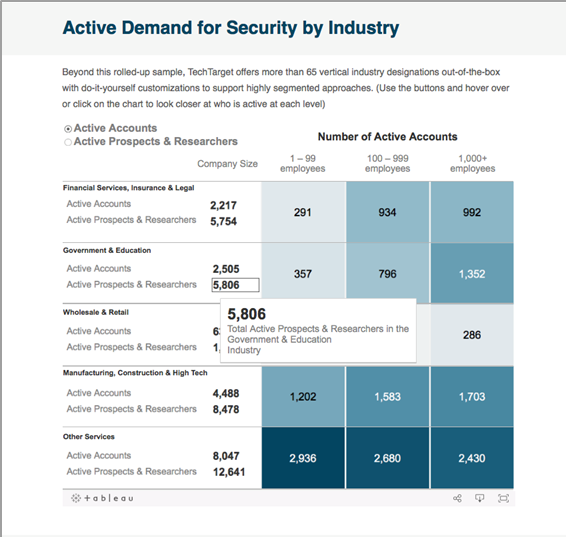Welcome to my new blog series, “Behind the Marketing,” which is inspired by the classic VH1 series, “Behind the Music,” but with a B2B marketing twist. Each month, I will spotlight a cool, eye-catching and thought-provoking campaign or project — and the marketers behind them.
This week, I caught up with John Steinert, Chief Marketing Officer at TechTarget, to get a glimpse into the company’s Active Demand Report campaign.
Sal LoSauro: What was the inspiration for this campaign?
John Steinert: The inspiration for this campaign was really the observation that too many marketers from companies are simply unaware of how much of the total demand in their marketplace they actually can’t even see. When we worked with clients to compare what they saw in their systems and via their website to what we can see in their market, the difference can be either thrilling or staggering depending on your personality. This is incredibly powerful information for companies big, small and in-between to use to look outside their own ecosystems to gain competitive advantage.
SL: How many team members were involved in developing the concept/theme?
JS: Developing this campaign required participation from our market experts, analytics department, creative and demand gen. While a core group of as little as three people probably drove it, there were as many as 10 involved.
SL: Did you use multiple assets to support the theme? Which ones were the most successful?
JS: The campaign was initially launched with a core of outbound email and social amplification, and a single asset that comprises three different report types targeting marketers in a single enterprise technology macrosegment. Based on response and conversion to opportunities and deals, it is being rolled out first to more macro-segments and then in different formats for inbound and to cover product extensions.
SL: How long did it to take to kick off from start to finish?
JS: Development of the initial wave required substantial technical work that is now in place to support the expansion. So from conception to implementation, it took about 20 weeks.

SL: How long did the campaign run?
JS: This campaign is really an entire acquisition program and it will continue to run until we build something even better. Based on the breadth and depth of our content network, audience and intent data, we have the ability to roll this out to multiple macro- and, ultimately, micro-segments in enterprise technology. We initially rolled out in the enterprise security market, but have since expanded to enterprise storage, cloud computing and networking markets with more to come.
SL: What were the other components?
JS: The campaign ports real purchase intent insights from our Priority Engine into a Tableau visualization engine that allows the recipient to play with the data at a high level. As this data is live, we can refresh it every week if we want, so the campaign evolves with market dynamics. Of course we needed to customize our landing pages a bit to make this all possible! Over time, as we expand the campaign, we’ll actually be using tighter and tighter list pulls and making the data more and more relevant by enterprise tech micro-segments and recipient roles.
SL: If you had to do it all over again, what would you do differently or the same?
JS: This is strategic work for us, so it’s really important to involve all the right people, because to scale it, we want to make the versioning as mechanized as possible. So, while the core team is quite small, we actually have our product development teams fully aware so that as we scale, they can support us with the tech extensions to help us.
SL: Any words of wisdom to others looking to embark on a similar campaign?
JS: I think the key here is that if you truly want to grow conversion rates, you need to do the work on your campaigns that will explain the key value you can bring in an easy-to-understand yet powerful way. Taking shortcuts on the concept and development inevitably leads to a reduction in performance.
SL: Can you share any results you’ve seen from the campaign?
JS: The campaign goes to substantially smaller, more segmented lists than our standard horizontal campaigns. Initial runs have showed that this campaign would deliver a 20% improvement on standard CTRs, 15% better registration and significant conversions to full custom walkthrough meetings for Priority Engine, so that marketing teams can see the specific purchase intent insight available to them in their market. In rollout, the campaign continues to deliver those numbers, which is why we’re expanding it to more outbound versions, international and inbound as fast as we can do the work.
SL: On a personal note, how did you get involved/your start in marketing?
JS: I studied Anthropology in college, which gave me a very good grounding in analysis and segmentation. The reality is, though, that I got my start in the industry as a copywriter, splitting my energies between the tech work that got me the job and the consumer content stuff that had attracted me in the first place. Over time, I fell in love with the complexity of enterprise tech marketing at scale but I’ve never lost my love of great content.
SL: If there a favorite band you’d love to see a Behind The Music special about?
JS: I’d like to go behind the scenes to hear and see more about the discussions, thinking and learning that helped Talking Heads transition from Talking Heads 77 through to Remain In Light.
Have an interesting or cool campaign you’d like to submit for consideration? Shoot me an email at [email protected].







